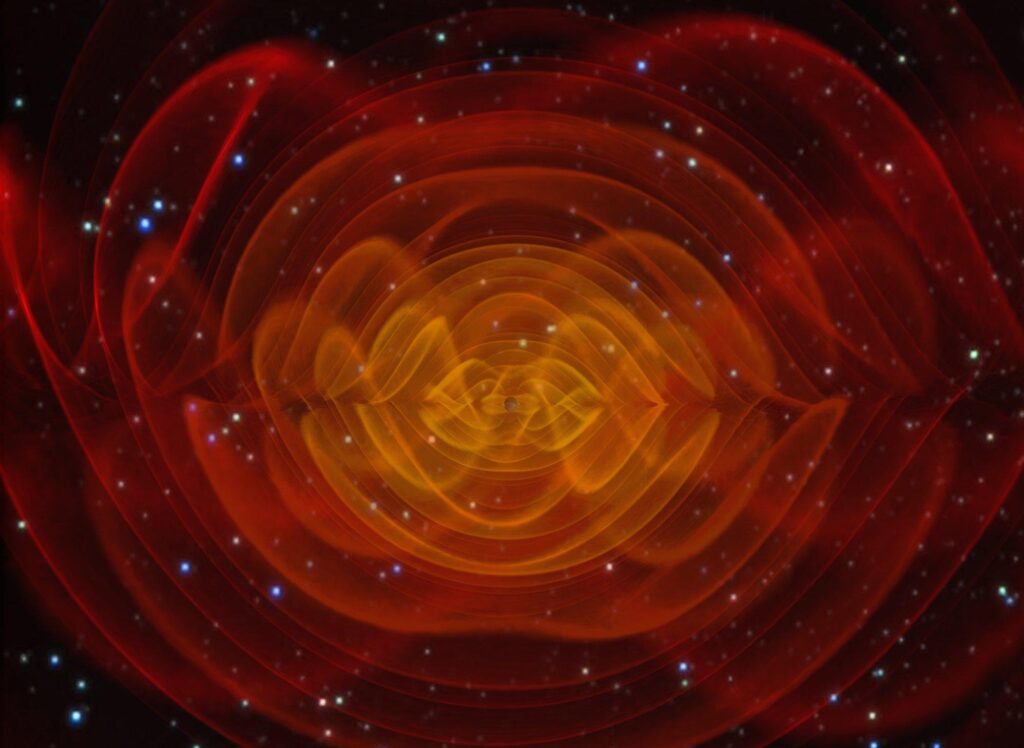Created by the movement of bodies of heavy masses and traveling through the vastness of space, the waveforms associated with the curvature of spacetime are known as the gravitational waves. Quite similar to the formation of ripples in a pond or a lake whenever you throw a stone in it, gravitational waves travel outwards through space.

Our Sun is an average star in the universe. There are many stars in other galaxies and throughout the universe which have masses many times larger than our Sun. When such bodies move and/or interact with similar bodies, they create ripples in the fabric of space. To understand gravitational waves, we need to understand ‘Gravity’ first.
Gravity During the Renaissance
Gravity is omnipresent, but nobody thought about it, and how it works up until modern times. In the 16th century, Isaac Newton, while sitting under an apple tree pondered over it, and developed a theory, and later a formula that became the foundation of gravity. The law came to be known as the Universal Law of Gravitation.
It was a universal law in the sense that it could explain every known object in the universe at that time which would obey that law. Right from an apple falling from a tree to the Moon orbiting the Earth to the planets in a continuous motion around the Sun, all these natural phenomena could be explained by Newton’s law of gravitation.
However, Newton was quite bothered about an aspect of his law of gravitation which he called ‘action at a distance’. He, in his lifetime, could not solve the mystery behind how the two objects attract each other lying in a vacuum of space and what could be the exact way of information exchange without them being in any physical contact.

A Modern Concept of Gravity
Along came another genius in the 20th century, Albert Einstein. He was very radical in his thoughts about gravity. Einstein proposed that gravity is not a force, it is geometry. According to him, a body with a mass lying in space warps the region of space around it.
You may consider it as an experiment in which there is a rubber sheet attached firmly to a few joints. You then place a heavy ball at the center which causes the rubber sheet to bulge inwards. Now, if you place a small marble on the sheet near the edge and as soon you release the marble, it will start following a circular motion around the center of the rubber sheet where the heavier body is placed, eventually colliding with the ball in the center.

In other words, matter tells space how to curve while the curvature tells matter how to move. In the real world out there in space, the same thing happens with the Moon and the Earth, and the planets around the Sun. The last part of the experiment doesn’t happen frequently, i.e. the moon never collides with the earth. Matter and the spacetime curvature are in a sort of precise conjunction in this case.
A Cosmic Collision
But there are also cases where two heavy massive objects spinning around each other collide at the end of their motion. This is precisely what happened 1.3 billion years ago in a region of space where a collision of two black holes resulted in the generation of gravitational waves which was detected by a sensitive detector called LIGO in the US. The waves emanating from that system, traveling through an enormous distance of 1.3 billion light-years, hit the detector on 14th September 2015 and the instrument was able to measure the waves with a high precision that hit our planet on its path.

The gravitational waves are important in the sense that they do not interact that much with matter as light does. A ray of light on its journey in the vastness of space loses out energy as it gets absorbed or scattered by the matter. On the other hand, gravitational waves can just traverse any interceding matter without being substantially scattered.
Who Likes to Party?
Consider it as a scenario in a party where you are accompanied by an extrovert person and you would like to leave as it is getting late. You convey your wish to your partner and he/she agrees to it, but as you are going towards the door, many people come to your partner and exchange wishes or start discussions, eventually delaying your departure. On the other hand, if you are accompanied by an introverted person and you wish to leave, which your partner also agrees with, and you both start moving towards the door, nobody is going to bother you much and you both will reach the door quickly and eventually depart much sooner.
A New Window
The essence of gravitational waves lies in one of their properties to carry information through a long distance in space without being impacted by normal matter. Information that these waves carry could still be very primordial, telling us the details about the time when they were created which was previously unattainable. Gravitational Wave Astronomy has opened a new window for scientists to look out in space and gain new insights about things that haven’t been known yet. A new era of astounding knowledge and research awaits us!!

